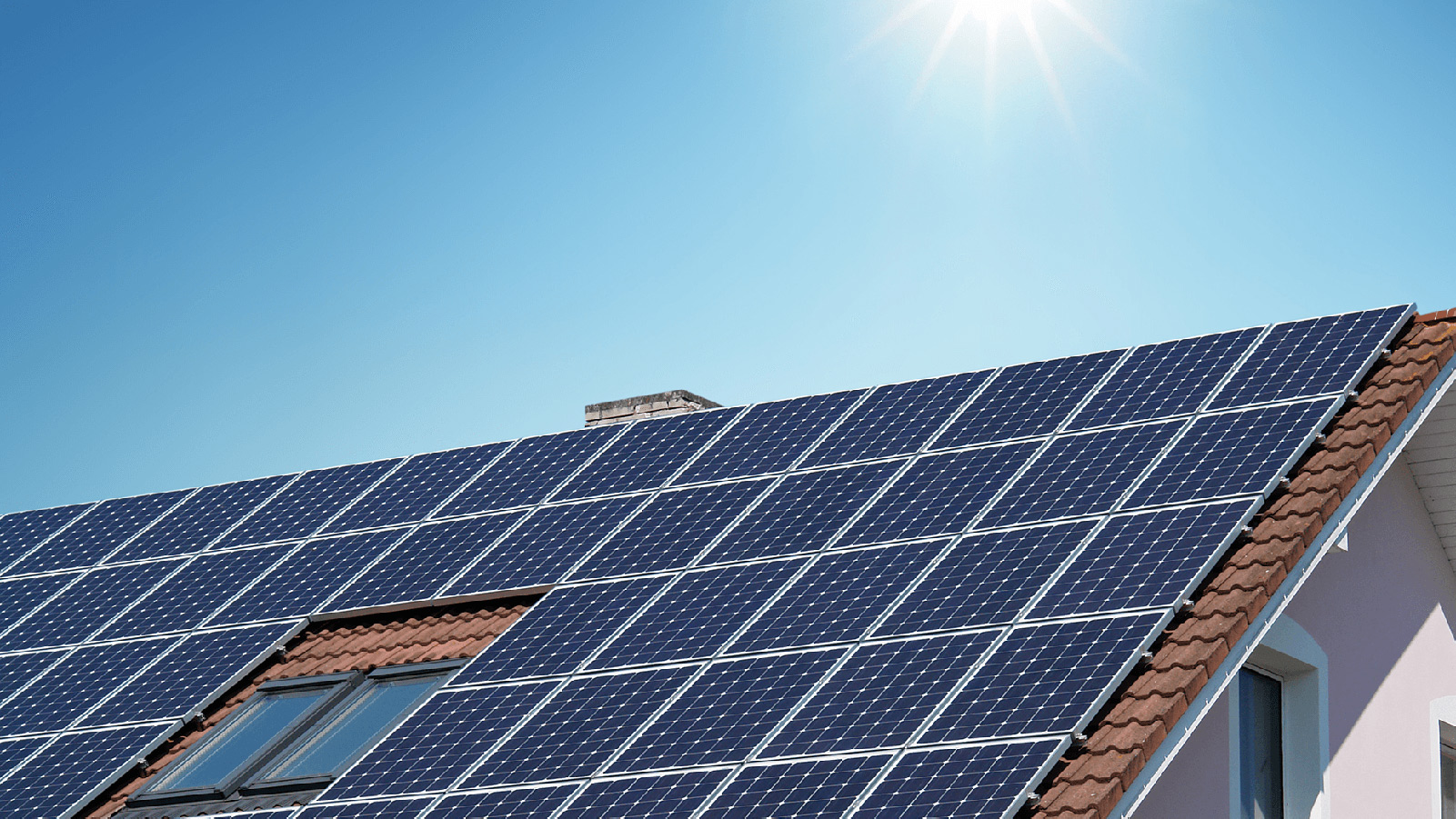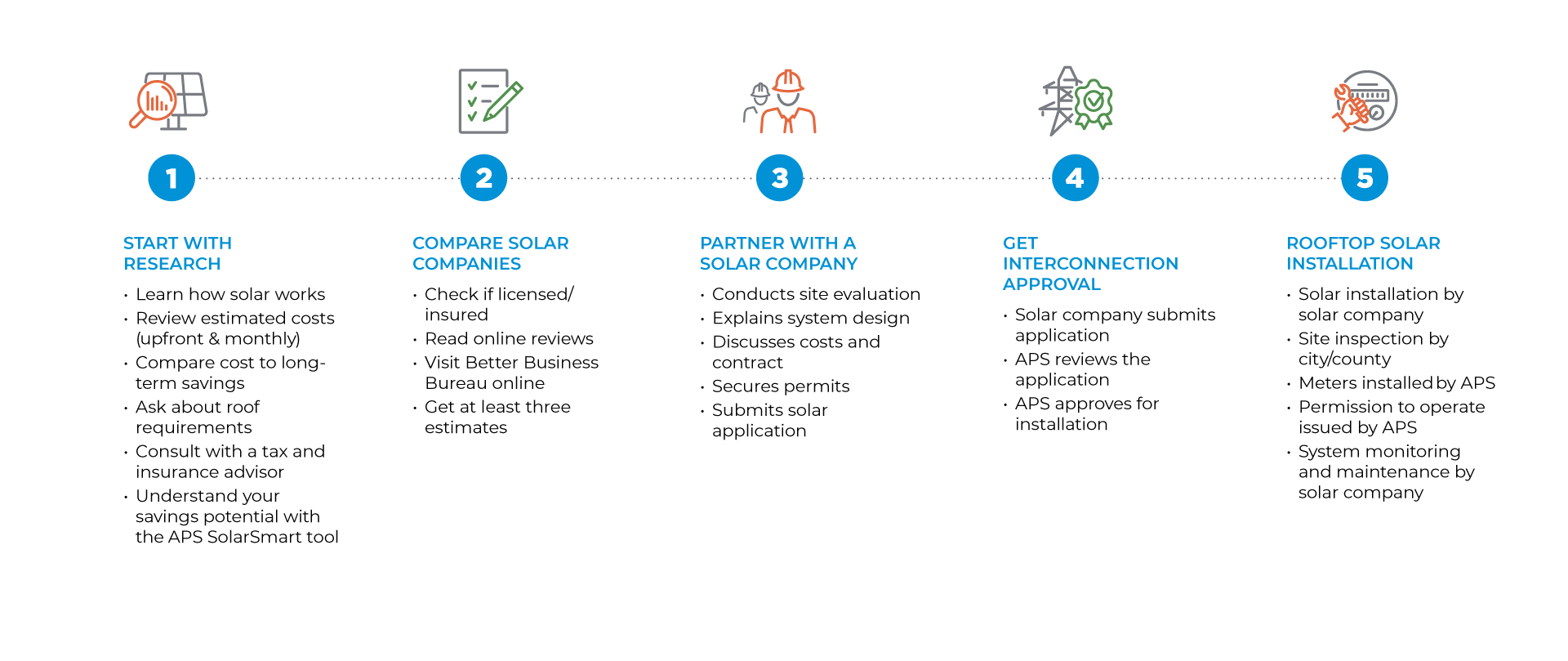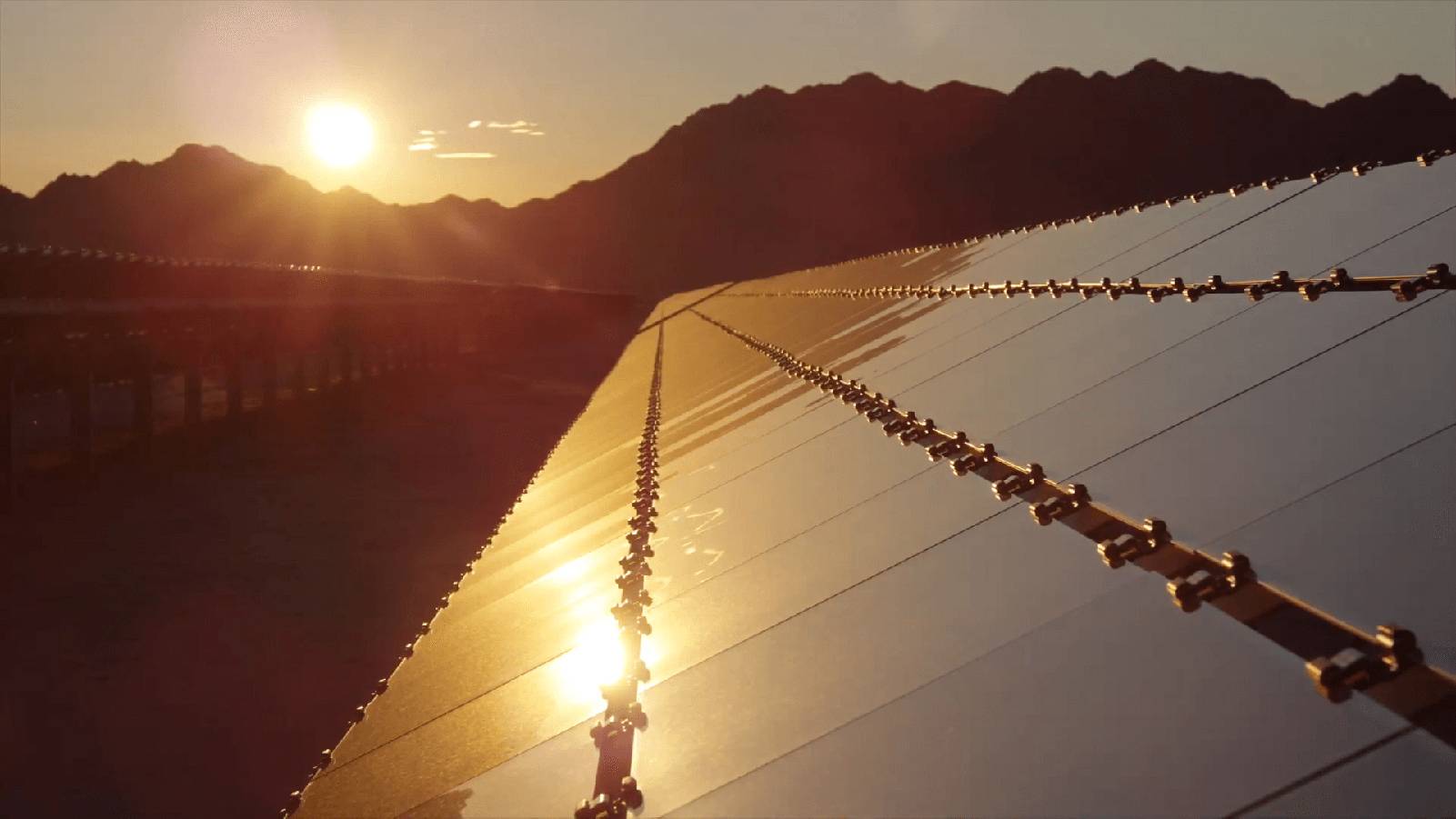APS provides support to customers installing equipment that connects with our grid, such as a solar system, a home battery or other type of generator. We want everything to go smoothly for you and your installer throughout the permitting and installation process. Please review our interconnection standards below — they protect your equipment and our electrical system, and keep everyone safe.
Header
Your Journey to Adding Rooftop Solar

Installing clean energy technologies like rooftop solar and batteries at your home or business are good for the environment and can reduce your energy bill. It’s also a big decision. There are many factors to consider before you make a choice and sign a contract. Learn more about your options, questions to ask and the connection process. Follow the steps below to make an informed decision on your home energy.

Is Solar Right for Me?
Find out with our SolarSmart education tool. Receive a customized solar (+ storage) estimate for your detached, single-family home to understand your savings potential installing a rooftop solar system. There are two ways to use the tool:
- Login to your aps.com account, access SolarSmart to use your historical energy usage data. (Must have at least 12 months of data to complete estimate.)
- Or access the SolarSmart tool to manually enter your APS service address and estimated monthly average energy usage when prompted. (Recommended for customers without 12 months of energy usage history.) Estimated savings are calculated using the Fixed Energy Charge Plan.
Please note: You will be redirected to a third-party site. Your information will not be stored or sold. You can view and download your report.
Solar Equipment 101: Panels, Batteries & More
Read up on common terminology to better understand the process and equipment, as well as whether a battery system to enhance your solar system would benefit you.
Rooftop Solar
- Solar Panels are installed on the roof or in the ground using racks and mounts, then capture energy from the sun and deliver that energy as direct current (DC) power to an inverter.
- Inverters convert the DC electricity from solar panels into alternate current (AC) electricity, which powers everything in your home.
- Meters enable you to monitor how much solar power your panels supply to your home, as well as the performance of your system.
- Optional Battery Systems will offer additional flexibility to your home energy use and generation, but add additional costs, separate from your solar system.
Find solar equipment that meets established national safety and performance standards.
Equipment Lifetime Expectancy
Verify lifetime expectancy with your installer and manufacturer, as life expectancy varies by equipment and region (i.e., Desert vs. Mountain). However, in general, a properly maintained solar system may last up to 25 years.
Options, Incentives & Bill Credits
Cash, loan or lease?
Choose the one that is best for you. Compare your financial options with our SolarSmart educational tool and consult with a qualified financial advisor to identify important considerations unique to your situation.
Are there any tax incentives for going solar?
We recommend consulting with a tax professional to see if you qualify for credits or you can search the Database of State Incentives for Renewables & Efficiency®.
Will I have an APS Bill?
Yes. Although your home has solar panels, it’s also connected to the power grid. This connection ensures you’ll have energy whenever you need it – at night, on cloudy days or anytime your solar system doesn’t generate enough energy to meet your needs in real time. Because you’re connected to the power grid, you’ll continue to receive a monthly bill.
Will I need a new rate plan?
Depending on your current rate plan, you may need to switch. You have two options to choose from:
-
Time-of-Use 4pm - 7pm Weekdays:
Shift energy use to lower-cost off-peak hours, when your solar system is producing the most energy during the daytime. Use less energy during higher-cost on-peak hours between 4pm and 7pm on weekdays. Watch this short video for tips. -
Time-of-Use 4pm - 7pm Weekdays with Demand Charge:
Get the benefits of our typical Time-of-Use plan with a monthly demand charge for the highest hour of usage during on-peak hours. Stagger usage during higher-cost on-peak hours between 4pm-7pm weekdays. Watch this short video for more info.
How will I get compensated for the excess solar energy I produce?
Any energy your system produces and you don’t use is bought by APS. The price at which it is bought and when you are compensated for it depends on a billing element called a renewable rider, also known as a buyback rate. The buyback rate is chosen by you or your solar company during the application process and you can change it any time. You have two options to choose from:
- Resource Comparison Proxy Export Rate (RCP): Bill credits are applied to your account monthly and any remaining credits roll over to the next month. At the end of each year, accounts with a credit balance of $25 or more are mailed a check and balances below $25 roll over to the next year. The credit amount will depend on which purchase rate you were placed on at the time you applied for your solar system.
- Renewable Energy Net Billing (EPR-2): Bill credits are applied to your account monthly and any remaining credits roll over to the next month. The credit amount will depend on the on-peak and off-peak purchase rates during the summer (May through October) and winter (November through April) seasons.
Why is Budget Billing not available with solar?
We know many of our customers enjoy the benefits of Budget Billing, a program that uses an average of your monthly energy use so that you can pay about the same amount each month. Due to the complex nature of solar billing, this program is unavailable to solar customers at this time.
Take Steps to Maximize Your Savings & Environmental Impact
You've done your research. You’ve made the decision to support clean energy that could reduce your monthly bills. Now, it’s time to choose the right installer and get up and running. Here’s how.
Choose the Right Installer
APS doesn’t sell rooftop solar systems, but we’re here to help guide you through the decision to invest in your home. Starting with choosing the right installer by following recommendations from our experts:
- First, collect your average monthly bill or total monthly energy usage from the past 12 months.
- Then, use our SolarSmart educational tool for more information on cost and logistics.
- Next, get a quote from three installers to compare options, as prices and warranties can vary. When deciding on your top three, keep these considerations in mind:
- Are the installers licensed and insured?
- Do they have a significant number of positive, online reviews?
- Do they have a good score with the Better Business Bureau?
- Ask your installer about their workmanship warranty and whether it covers your roof. The party responsible for repairs will depend on your unique situation and contract agreements.
More Factors to Consider
Going solar is a big decision. While your installer will have the expertise to equip you with the system that best suits your home, you can prepare by understanding best practices to make the most of your system. Remember, even with Arizona’s abundant sunlight, being strategic in your panel placement is key.
Panel Placement
To maximize your system production, here are a few best practices to consider for panel placement:
- Shading: Obstructions like trees have a big impact on how much sunlight you receive.
- Panel tilt: Multiple tilts or orientations can hinder energy production.
- Panel direction: Western exposure is best for capturing maximum sunlight.
Production Meter Access
APS needs 24-hour unrestricted access to the new meter and utility disconnect. Production meters cannot be placed behind any type of gate or fence or be placed under a patio or any type of roof overhang or extension.
Insurance and HOA
Policies vary, so double check if your insurance company covers solar before installing. Be sure to review your plans with your HOA as well, as its rules may affect system location.
Selling Your Home with Solar
If you are considering selling your home, consult with your real estate agent before installing a solar system.
Understand Your APS Rate Plan & Billing
It’s important to understand how rates work so you know the best times to use energy and save money.
Your New Rate Plan
You can still shift your energy usage to off-peak times with solar. Pick the right plan to get the most savings out of your system.
- Time-of-Use 4pm - 7pm Weekdays: Shift energy use to lower-cost off-peak hours, when your solar system is producing the most energy during the daytime. Use less energy during higher-cost on-peak hours between 4pm and 7pm on weekdays. Watch this short video for tips.
- Time-of-Use 4pm - 7pm Weekdays with Demand Charge: Get the benefits of our typical Time-of-Use plan with a monthly demand charge for the highest hour of usage during on-peak hours. Stagger usage during higher-cost on-peak hours between 4pm-7pm weekdays. Watch this short video.
Buyback Rate for Your System
Any energy your solar system produces that you don’t use is bought by APS. The price at which it is bought and when you are compensated for it depends on a billing element called a renewable rider, also known as a buyback rate. The buyback rate is chosen by you or your solar company during the application process and you can change it at any time. You have two options to choose from:
- Resource Comparison Proxy Export Rate (RCP):
- Any remaining credits roll over to the next month.
- Accounts with a balance of $25 or more will be mailed a check at the end of each year.
- Balances below $25 will roll over to the next year.
- The credit amount will also depend on which purchase rate you were placed on when you applied for your solar system.
- Renewable Energy Net Billing (EPR-2):
- Any remaining credits roll over to the next month.
- The credit amount will depend on the on-peak and off-peak purchase rates during summer (May through October) and winter (November through April) seasons.
Solar Energy Production and Bill Credits
"Production" is the overall electricity generation of your solar system. "Credit" is the excess energy (kWh) produced by your solar system and sent to our power grid. Any excess kWh is applied to your bill in the month generated.
Budget Billing Is Not Available with Solar
We know many of our customers enjoy the benefits of Budget Billing, a program that uses an average of your monthly energy use so that you can pay about the same amount each month. Due to the complex nature of solar billing, this program is unavailable to solar customers at this time.
Questions for Your Solar Installers
Wondering what questions you should ask your potential solar installers? Here’s a list to help get you started.
- Are you bonded, insured and what’s your BBB rating?
- What happens if there’s damage to my roof?
- Who else should I consult before proceeding?
- What does the application and installation process look like and how long does it take?
- Will I get any solar tax incentives, credits or rebates?
- What is the system warranty?
- What are the system costs and financing options?
- What are the different panel types?
- How many panels should my system have, where will the panels go on my roof and how much energy will it produce?
- Who’s responsible for system panel maintenance and/or repair and how often do panels need to be replaced?
- How long before the system pays for itself?
Congratulations on Getting Solar
Congratulations on making it to the finish line. Now that you have solar installed, you’ll want to get familiar with the changes you can expect and properly care for your investment.
Your New APS Bill
Although your home has solar panels, it’s also connected to the power grid. This connection ensures you’ll have energy whenever you need it – at night, on cloudy days or anytime your solar system doesn’t generate enough energy to meet your needs in real time. Because you’re connected to the power grid, you’ll continue to receive a monthly bill, but it will look a little different. On your new bill, you’ll see:
- Rate plan: You can choose either “Time-of-Use 4pm-7pm Weekdays” or “Time-of-Use 4pm-7pm Weekdays with Demand Charge”
- Energy usage: Typical cost breakdowns and comparisons
Renewable Rider (Buyback Rate): Any energy your solar system produces – and you don’t use – is bought by APS. You’ll receive a monthly bill credit.
- Grid access charge: To better align with the cost of service, your rooftop solar bill includes a grid access charge.
Shifting Energy Usage
Save money by shifting the bulk of your energy usage to when your solar system is producing, during the daytime. To save when your solar system isn’t producing, use your major appliances like the washer, dryer, dishwasher and oven during lower-cost off-peak hours.
Monitoring System Performance
It’s a good idea to monitor your solar production to make sure your system is running optimally despite weather and seasonal changes. If you notice major fluctuations in your solar production, contact the company who installed your system. It’s also important to keep copies of all warranties handy.
Viewing Your Solar Production
Log in to your APS account to see how much solar energy you sent us. Check with your solar installer to learn how you can view your total solar production, as some installers may have an app available. You may also want to revisit your contract to see if production guarantees are included.
System Upgrades and Replacements
Keep informed through routine conversations with your installer as your system ages to know when it’s time to replace the inverter, panels and if you added storage, the battery. If you ever need to replace equipment, we require an application for any updates that will increase the size of your system by more than 1 kW or 10%, whichever is greater.
For changes up to 1 kW or 10%, please email renewables@aps.com to request an Equipment Amendment form on your existing application.
Your System During an Outage
To keep our employees who are working to restore power safe, we stop the flow of energy through the power grid in the area. If you have a backup battery or solar generator, you will still have power.
Selling Your Home with Solar
Consult with your real estate agent to learn about options for selling your home with a solar system.
Have More Questions About Maintaining Your Solar System?
Get expert advice to help keep your rooftop solar system running smoothly for years to come. Contact your solar installer for more information.

We are committed to clean energy

Your choice to choose green
Information for Installers
Installers can submit an interconnection application, or find useful information, forum updates and communications below that will keep them in the know. The Interconnection Process Guide can help you get started. You can also contact us at 602-216-0318 (800-659-8148) for more information.
Customers can view their existing interconnection application and APS program applications. It's important to know that access must be granted by the applicant in order to view your interconnection application.
2023 Interconnection Forum - DRE Interconnection Updates and Reminders
2023 Interconnection Forum - Field Services Meter Sets Derates and Labeling
2023 Interconnection Forum - Interconnection Application Volume
2023 Interconnection Forum - PowerClerk Updates and Reminders
2023 Interconnection Forum - Production Report
2022 Interconnection Forum - Interconnection Application Volume
2022 Interconnection Forum - DDSR Tariff and Residential Battery Pilot Updates
2022 Interconnection Forum - DRE Interconnection Updates and Reminders
2022 Interconnection Forum - Field Services Meter Sets Derates and Labeling
2022 Interconnection Forum - Power Clerk Reminders
2021 Interconnection Forum - Distributed Resources Engineering
2021 Interconnection Forum - PowerClerk Reminders
2021 Interconnection Forum - DDSR Aggregation Tariff and Residential Energy Storage Pilot
2021 Interconnection Forum - Meter Sets, Derates and Labeling
2020 Interconnection Forum - Engineering Update
2020 Interconnection Forum - Field Services 2020 Interconnection Forum - PowerClerk
2020 Interconnection Forum - Production Report
2020 Interconnection Forum - Renewable Energy
2019 Interconnection Forum - Application Error Rate
2019 Interconnection Forum - Solar Partner Program Phase II Lessons Learned
2019 Interconnection Forum - Engineering Updates
2019 Interconnection Forum - Rate Riders and Reminders
2019 Interconnection Forum - Communication and Resources
May 2018 Interconnection Forum - Energy Storage and EV Programs
May 2018 Interconnection Forum - DER
May 2018 Interconnection Forum - New Residential Rates and Rate Riders
May 2018 Interconnection Forum - Engineering
May 2018 Interconnection Forum - Communications
April 2016 Interconnection Workshop - Interconnection Requirements
April 2016 Interconnection Workshop - Interconnection Administration Application Process Overview
Interconnection Documents and Requirements
Assignment and Assumption of Contract
Disclaimer
Sample Executed Contract
W-9 Form
Arizona Administrative Code - Distributed Generation Interconnection Requirements
APS Electric Service Requirements Manual
APS Interconnection Requirements
Load Side Connection Requirements
Supply Side Connection Requirements
Pre App Customer Form
Applicant User Guide
Authorization Form
Distributed Energy Administration Plan (DEAP)
Interconnection Agreement
Interconnection Study Agreement
Interconnection Process Guide
Non-Parallel Connection Agreement
Assignment and Assumption of Contract Commercial
Non-Incentive Commercial System Ownership Information Change Form
Non-Residential ACH Form
PBI Information Change Form
Typical Commercial Diagram (Load Side Tap)
Commercial Diagram Requirements - Rotating Machinery
Typical Commercial Diagram (Line Side)
Typical Commercial Diagram (Load Side)
Interconnection Agreement (Non-FERC sample)
Non-FERC Interconnection Process Overview
Non-FERC Interconnection Queue Policy
APS ESS Metering and Isolation Concept Drawings
APS PV Solar Metering and Isolation Concept Drawings
Consumer Acknowledgement
Diagram Checklist
Example Equipment Tags
Letter-in-Lieu of Electrical Clearance Form
Plan Review & Installer Guidelines Checklist
Single Phase 120-240V Fault Current AC Disco Guide
Typical Wind Diagram
Utility Disconnect Checklist
No document to display for Residential getting started
200A Typical Residential Diagram for Load Side Connection
240V AC Coupled Battery System Diagram
Meter Socket Adapter Sample Diagram
400A Typical Residential Diagram for Load Side Connection
240V DC Coupled Battery System Diagram
400A Typical Residential Diagram for Load Side Tap
Typical Residential Diagram for Supply Side Tap







